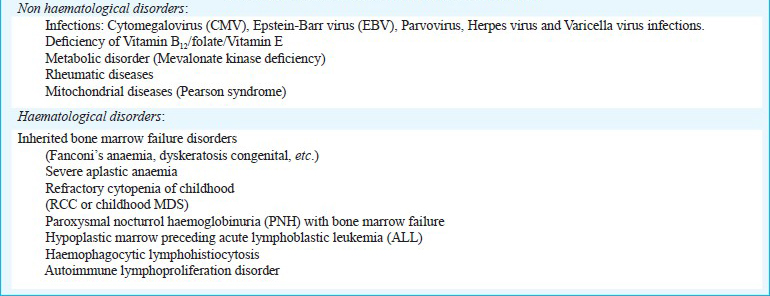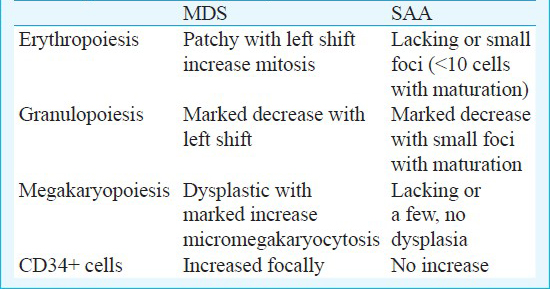Translate this page into:
Cytogenetics in paediatric aplastic anaemia: Does it give an insight on the evolution of the disease?
This is an open-access article distributed under the terms of the Creative Commons Attribution-Noncommercial-Share Alike 3.0 Unported, which permits unrestricted use, distribution, and reproduction in any medium, provided the original work is properly cited.
This article was originally published by Medknow Publications & Media Pvt Ltd and was migrated to Scientific Scholar after the change of Publisher.
Paediatric aplastic anaemia is difficult to discriminate from paediatric myelodysplasia and many other inherited bone marrow failure syndrome (IBHF)1. The difficulty in diagnosis arises because cytopenia and marrow hypoplasia in paediatric age group also comes with several non haematological disorders (Box)2. In this issue Gupta et al3 presented cytogenetic profile in 42 children with varying severity of disease. Five patients showed cytogenetic abnormality, and two of these five patients had monosomy 7 and 7q abnormality, one patient had trisormy 8 and one had 5q abnormality. This result is deceptive because the investigators started the study with 71 patients. In these 71 patients, 29 had uninformative study. It would have been proper to document five abnormal cytogentics out of 71 patients (8%) rather than 42 patients as described in the paper3. When marrow is hypocellular it is difficult to distinguish between idiopathic aplastic anaemia, myelodysplastic syndrome (MDS), and IBMF syndromes. The investigators have correctly excluded Faconi's anaemia by appropriate DNA stress testing.

- Disorders in children with hypoplastic bone marrow
One of the deficits of the present study is the lack of detailed morphological study with bone marrow smear, trephine biopsy and marrow immune histochemistry. These studies are important because there are significant differences in paediatric MDS and paediatric aplastic anaemia in those investigative parameters as shown in the Table2. Broadly in MDS there are foci of cellular hyperplasia with loss of proper differentiation, megakaryocytic cells may not be morphologically discernable but may be revealed by immunohistochemistry, whereas in aplastic anaemia generally foci of hyperplasia are not seen, even if present, there are no CD61 stainable micromegakaryocytes or CD34+ cells and differentiation is normal4.

The discrimination between aplastic anaemia and refractory cytopenia of childhood (RCC) which is the other name given for childhood MDS may not be clear cut. Experimental5 as well as clinical studies67 have shown that a proportion of cases with severe marrow damage leading to marrow aplasia may progress on follow up to MDS and even a small proportion of these cases will progress to acute myeloid leukemia (AML). It has been questioned whether granulocyte-colony stimulating factor (G-CSF) therapy in non responders to immunosuppressive therapy is a risk factor for the development of MDS6, however, MDS developing in donor cells long after allogenic stem cell transplantation suggests a microenvironmental defect in this condition8. Involvement of chromosome 7 has been shown to be frequent in children with MDS in contrast to chromosome 5 as has been described for adult cases9, other common chromosomal abnormalities like trisomy 8 and trisomy 21 are reported to be other common abnormalities. Trisomy 8 has also been reported by Gupta et al3. There are paucity of data on cytogenetics in paediatric aplastic anaemia from this country and elsewhere in the world probably because of technical difficulty in obtaining enough cells in cycle in aplastic anaemia. Modern FISH based technology will go a long way in reducing this problem by providing information on chromosomal abnormality in interphase cells, moreover, techniques are now evolving where karyotyped cells can also be immunophenotyped to provide exact lineage and differentiation status of these cells.
In view of paucity of data on cytogenetics of paediatric aplastic anaemia, the article by Gupta et al3 is an important addition to the world literature. However, there are two important weaknesses in this paper, viz. lack of detailed morphological data of the patients on marrow smear and trephine and secondly a large number of failed karyotypes and so called normal karyotypes were not studied by molecular cytogenetics (FISH and other hybridization techniques). In fact as these studies are possible on old and preserved smears and other specimens, serious attempts should be made to complete these studies on all 71 cases and chromosomal defects should be correlated with duration of aplasia rather than first time presentation to a given centre.
The moot question whether clonal chromosomal abnormality is a part and parcel of biology of a small subset of aplastic anaemia or it is an evolving complication in the natural history of the disease through MDS or not has not been answered by this study. X chromosomal inactivation studies have shown that up to 20 per cent of aplastic anaemia patients may have clonal haemopoiesis10 and similar evolution of PNH like clones in the same disease also points to evolution of clonal haemopoiesis in this disease.
References
- Myelodysplastic syndromes in children: a critical review of issues in the diagnosis and classification of 887 cases from 13 published series. Arch Pathol Lab Med. 2007;131:110-6.
- [Google Scholar]
- Classification of childhood aplastic anaemia and myelodysplastic syndrome. Haematology. 2011;201:84-9.
- [Google Scholar]
- Cytogenetic profile of aplastic anaemia in Indian children. Indian J Med Res. 2013;137:502-6.
- [Google Scholar]
- Hypoplastic myelodysplastic syndrome can be disctinguished from acquired aplastic anaemia by CD34 & PCNA immune staining of bone marrow biopsy specimens. Am J Clin Pathol. 1997;107:268-74.
- [Google Scholar]
- Aplastic anaemia and the hypocellular myelodysplastic syndromes histomorphological diagnostic and prognostic features. J Clin Pathol. 1985;38:1218-24.
- [Google Scholar]
- Risk factors for evolution of acquired aplastic anaemia into myelodysplastic syndrome and acute myeloid leukaemia after immune suppressive therapy in children. Blood. 2002;100:786-90.
- [Google Scholar]
- Aplastic anaemia and monosomy 7 associated dysmega karyocytopoiesis. Am J Clin Pathol. 2006;126:925-30.
- [Google Scholar]
- Donor cell myelodysplastic syndrome developing 13 years after marrow grafting for aplastic anaemia. Cancer Genet Cytogenet. 2003;142:124-8.
- [Google Scholar]
- Complex karyotype newly defined: the strongest prognostic factor in advanced childhood myelodysplastic syndrome. Blood. 2010;116:3766-9.
- [Google Scholar]
- Clonal hematopoiesis as defined by polymorphic X linked loci occurs infrequently in aplastic anaemia. Blood. 1995;86:2938-47.
- [Google Scholar]





